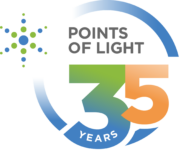Ask a CSR Friend: Setting Realistic Goals for the New Year

Looking for CSR advice?
Hear from our experts in our Ask a CSR Friend monthly column.
Whether you’re a novice or a seasoned pro, we know it takes a village to create vibrant workplaces where employees are equipped to contribute to the communities and causes they care about. So, when you need a trusted advisor to lean on, rely on Points of Light to be Your CSR Friend. Each month, our experts share their wisdom and wit to address a specific but often universal challenge related to your work as a corporate social impact practitioner.
Have questions about employee community engagement? Submit your question and it may be featured in a future blog post.
Dear CSR Friend,
It’s time to set our employee volunteer program’s goals for the new year and, after leading this work for the past four years, I’m struggling to balance ambition with what’s achievable. Leadership seems focused only on numbers – mainly increased participation and higher outputs. But I want to ensure the program evolves strategically and is aligned with community needs, employee interests and definitely company objectives so my budget remains intact. I want to focus on boosting engagement and strengthening partnerships, which I believe will deliver greater impact, but I’d really value your advice. What would you recommend to guide my planning?
Signed,
—Ambitious and Attainable in Atlanta
Dear Ambitious and Attainable,
The start of a new year brings with it possibility and potential. It’s the perfect time to think about what you and your leadership want to accomplish in 2025. But let’s be honest—goal setting can quickly veer into the land of the unrealistic and vague, leading to frustration and missed opportunities for impact. The key? Set realistic, measurable goals that stretch your program without snapping it (or you) in half.
Why Realistic Goals Matter
Realistic doesn’t mean small. It means thoughtful, data-informed, and achievable—pushing your program forward while respecting current capacity. Here’s how to get there:
- Know Your Capacity: How supportive is your program’s infrastructure? What resources—human, financial, technological and otherwise—are reasonably available?
- Engage Stakeholders: Align with leadership, employees, and nonprofit partners to find shared priorities.
- Pro tip — now is the time to start co-dreaming with your community partners as you begin to map out goals for the year. Remember that changing or adding to goals mid-stream can create an undue burden for the nonprofit.
- Use Data as Your Compass: Review participation rates, feedback and impact metrics from the past to set future benchmarks.
For example, skip “Let’s double participation!” and aim for something like: “Increase employee engagement by 20% by removing barriers, refining communication and introducing new volunteer formats.” Make a 2025 plan to host listening sessions to uncover what’s keeping people on the sidelines. Here’s a bold idea: move away from strict participation metrics and focus on creating greater access. Yes, leadership might cringe initially desperate to compare your company’s average participation rate with industry standards, but greater access is the key to inclusion — and meaningful impact.
Collaboration: Your Secret Weapon
Want to make a bigger splash? Collaborate more deeply, both internally and externally.
- Community Partners: Co-create strategies and goals with your nonprofit partners. They know their needs better than anyone else.
- Internal Teams: Strengthen relationships across departments. The Civic 50 honorees excel here — 100% of 2024 honorees integrated social impact with diversity teams, 94% with marketing/PR, and 86% with supplier diversity. Take note: cross-functional integration amplifies impact.
Measure to Improve (Not Just Prove)
The most impactful programs make measurement a habit, not an afterthought. Evaluations aren’t just about counting trees planted; they’re about uncovering insights to refine your program. Here’s why it matters:
- Track Progress: See where you hit, missed or exceeded your goals—and why.
- Spot Trends: Participation data and employee feedback can reveal what works (and what doesn’t).
- Learn from Challenges: Use obstacles as a guide for improvement—whether it’s accessibility, communication or partner alignment.
- Plan Smarter: Armed with insights, you can set sharper goals next year.
Consider leveraging tools like The Civic 50 to analyze your strategy. Even if you’re not aiming to become an honoree, the scorecard and benchmark report can spotlight strengths and gaps in your program, policies, and partnerships.
Close the Loop
Evaluation isn’t just for you; it’s a chance to share successes and lessons with stakeholders. Transparency builds trust and reinforces commitment. For example, if employees preferred hands-on volunteering over virtual options, let them know you’re planning more in-person opportunities. Show them their voices matter.
Do Better, Not Just More
This year, focus on setting goals that matter—for employees, the business and the community. Realistic, data-driven goals paired with right-sized strategy, collaboration and thoughtful measurement create a sustainable, high-impact program. In the new year, let’s commit to not just doing more but doing better—because that’s where the volunteer magic happens.
Until next time,
Your CSR Friend
Learn more about how we can help you level up your employer’s social impact efforts and why your company should join top corporate social impact leaders and become a member of the Points of Light Corporate Service Council. Still have questions? Don’t forget you can always ask a CSR friend!


